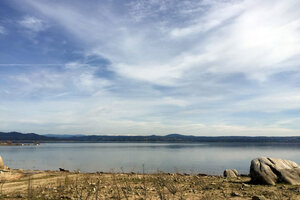Obama calls for proactive drought strategy. What would that look like?
The administration released an action plan Monday to help government agencies deal with the impacts of drought, which are expected to get worse as the climate changes.

The water level of Folsom Lake is pictured near Folsom, California February 11.
Jane Lee/Reuters
While on his three-day trip to Cuba, President Obama released an action plan on Monday to help the federal government proactively deal with drought, which affects one-eighth of the continental US population, mostly in the West.
In a memorandum and accompanying action plan, Mr. Obama’s administration outlined his goals for the federal government to help the country prevent and cope with drought, which scientists expect will worsen with changing climate conditions.
The president is calling for better data collection and sharing among federal, regional, state, tribal, and local authorities; better communication of drought’s risk, particularly to critical infrastructure; and government support of research and innovation in areas of water conservation and efficiency.
“Extreme, widespread drought challenges the security of the US food supply and the integrity of critical infrastructure, causes extensive economic impacts, and increases energy costs,” the Obama administration said in its action plan.
“In the context of a changing climate, the likelihood of increased frequency, duration, and intensity of droughts will further necessitate this range of concerted action,” the administration said.
About 12.5 percent of the continental US was experiencing drought as of mid-March, said Alice Hill, a key Obama aide on this issue. California is in its fifth year of drought, though it recently experienced a bit of a break as days of relentless rain storms there were hailed a “miracle” for replenishing reservoirs and snowpack to levels not seen in years.
"It's definitely a step in the right direction, but it's not a panacea. We're not saved," warned Shane Hunt, a spokesman with the federal Bureau of Reclamation, which oversees Lake Shasta, California's largest reservoir, in The Los Angeles Times. "We dug a pretty big hole in a lot of spots."
Federal agencies last year pledged $110 million in drought aid “to support workers, farmers and rural communities suffering from drought and to combat wildfires,” said the administration. This is on top of the $190 million federal agencies have invested to support drought-stricken communities in 2015 and the $1.2 billion the US Department of Agriculture was expected to distribute last year to livestock producers facing business losses because of the drought.
This report contains material from The Associated Press.

